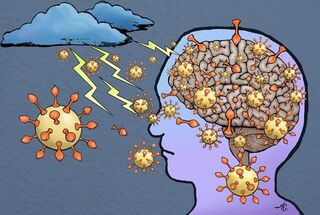Coronavirus Disease 2019
Research Suggests Coronavirus Causes a Storm in the Brain
A new study finds a COVID-related protein crosses the blood-brain barrier.
Posted December 20, 2020 Reviewed by Hara Estroff Marano

William A. Banks has been studying HIV for years. He'd done a lot of work on the gp120 protein in HIV-1, the protein that is responsible for the brain fog so common in HIV. That's because gp120 crosses the blood-brain barrier and is likely toxic to brain tissues. So when Banks started hearing about the long-term brain fog happening in people who've had COVID-19, he said in a news release, "it was like déjà vu."
Banks began wondering if the spike protein in SARS-CoV-2, the virus that causes COVID-19, behaved similarly to gp120. He and his team, which studies the blood-brain barrier in Alzheimer's, obesity, diabetes, and HIV, got to work.
Their study, published in Nature Communications, found that the SARS-CoV-2 spike protein, known as S1, can cross the blood-brain barrier in mice. And in very bad news for the brain, the spike protein then causes inflammation in the brain. If this holds true for humans, that inflammatory response may lie at the root of COVID-19 brain fog.
COVID-19 is scary enough as it is. It can make people incredibly sick or kill them. Survivors of COVID-19 may experience long-term lung or heart damage. In fact, inflammation of the heart is such a problem, the American Academy of Pediatrics has issued guidelines for pediatricians on when young athletes can return to competition after COVID-19. In some cases, the kids may look well but imaging finds alarming inflammation in the heart.
But the reality that COVID-19 leaves a long-term mark on the brain for some survivors is particularly frightening. Increasing numbers of people report difficulty thinking, clouded cognition, and fatigue for months after suffering from an infection with the novel coronavirus.
The COVID-19 Spike Protein
The spike protein (S1) is a binding protein. In pictures, it is shown as the red things sticking out of the virus. But in the body, the spike protein grabs onto cells so the COVID-19 virus can enter them. That means that the novel coronavirus can only enter cells where the spike proteins can grab on. The fact that the virus can only successfully attack some cells and not others explains the symptoms we see.
Banks's team studied the spike protein in mice. Not only did they find that it crossed the blood-brain barrier, but also that it likely triggered an inflammatory response. Inflammation is a big player in COVID-19 infection, considering that the postulated cytokine storm is the reason some people get so much sicker. Banks believes that when the S1 protein crosses the blood-brain barrier, it could produce a similar storm in the brain. The brain may respond to the spike proteins by releasing cytokines and other inflammatory chemicals.
What happens next is cognitive side effects and brain fog.
Even worse, this could impact a sick person's ability to breathe. "We know that when you have the COVID infection you have trouble breathing, and that's because there's infection in your lung, but an additional explanation is that the virus enters the respiratory centers of the brain and causes problems there as well," said Banks.
This is not good news, and it does not provide new insights for therapy. Banks' advice? "You do not want to mess with this virus," he said. "Many of the effects that the COVID virus has could be accentuated or perpetuated or even caused by the virus getting in the brain and those effects could last for a very long time."


